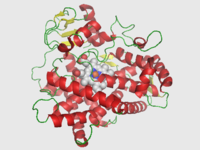
Photo from wikipedia
Over 20% of Food and Drug Administration (FDA)-approved drugs in the United States are metabolized by the hepatic enzyme cytochrome P450 2D6 (CYP2D6). The gene encoding CYP2D6 is highly polymorphic… Click to show full abstract
Over 20% of Food and Drug Administration (FDA)-approved drugs in the United States are metabolized by the hepatic enzyme cytochrome P450 2D6 (CYP2D6). The gene encoding CYP2D6 is highly polymorphic and genetic variation has been shown to impact drug response for many commonly dispensed drugs including opioids and antidepressants. Thus, it is important to understand an individual's CYP2D6 metabolizer status to optimize treatment outcomes for patients taking medications that are metabolized by this enzyme. Consequently, clinical CYP2D6 pharmacogenetic testing is being implemented by a growing number of health centers. Furthermore, clinical guidelines currently recommend adapting therapeutic regimens based on CYP2D6 genotype-informed phenotype. However, CYP2D6 genetic variation varies considerably across global populations and many allelic variants, or star alleles, are predominantly found in certain ancestral populations. Although CYP2D6 genetic variation has been extensively studied, there is still a paucity of information for many non-European populations. As has been shown for other pharmacogenes in randomized controlled trials, results from European populations cannot simply be extrapolated to other groups and in some cases even has the potential to cause harm. Therefore, enhanced inclusion in pharmacogenetic studies is urgently needed to increase ancestral representation, determine the extent of global CYP2D6 genetic variation (e.g., ancestry-specific variants), and determine the clinical impact of this variation on clinical treatment outcome. This review highlights knowledge gaps, challenges, and future directions in CYP2D6 pharmacogenomics through a unique pharmacoequity lens to address health inequities that hamper our ability to optimize drug therapy for improved pharmacological outcomes in diverse populations globally.
Journal Title: Clinical pharmacology and therapeutics
Year Published: 2023
Link to full text (if available)
Share on Social Media: Sign Up to like & get
recommendations!